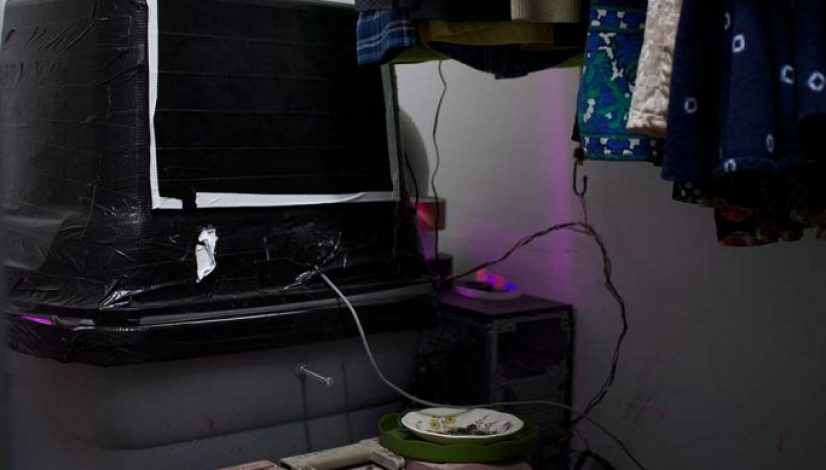Buckets Full Of Sunshine: How To Make Your Own Space Buckets
The post Buckets Full Of Sunshine: How To Make Your Own Space Buckets appeared first on High Times.
The latest cultivation trend: growing lush pot plants in tiny grow chambers that anyone can build. Here’s how to make your own space bucket.
Micro-Growing Space Bucket Style
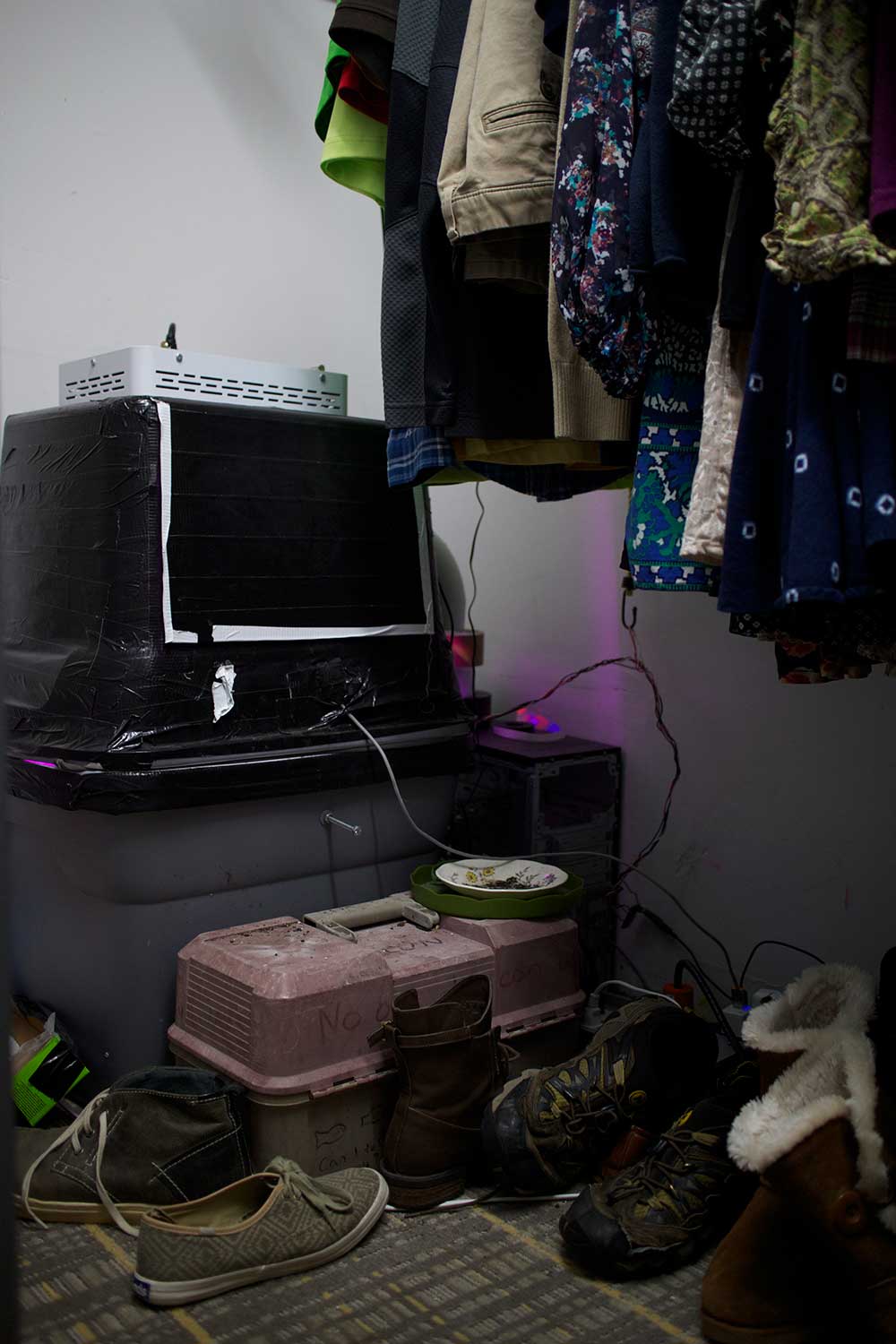
Space buckets are compact enough to hide in a tight closet. (Photo by Alex Royan/High Times)
In the finished basement of a rambling green home on a sandy residential street a stone’s throw from the blue-gray ocean of Massachusetts’s South Shore, John is ushering us down into the cramped bedroom closet where he keeps his space bucket.
Let’s be clear: We’re not just peering into the closet—John, myself and my photographer are all crowded inside it, personal space at a premium, ducking to avoid clothes on hangers to check out the bucket itself, which is stashed against the wall next to a tackle box and some old boots. It’s about the size of a mini-fridge, fashioned from two Sterilite tote buckets, the top one wrapped in a layer of black duct tape to prevent light from a 300-watt Mars Hydro LED system mounted to the top from escaping. Three ventilation fans hum faintly, and a narrow band of purple light leaks from the seam between the buckets.
John opens the lid, and inside is a 6-week-old female 707 Headband plant growing in the soil of a small pot, its pale buds just starting to flower in the otherworldly glow. Its minute size is striking: Indicas in particular, John says, will adapt to the constrained space, and he’s helped keep this one to a bushy height of about six inches with a combination of topping and low-stress training. When he harvests it next month, he expects it to have grown to no more than eight inches—and to end up with about an ounce of dank flower.
Bucket Yields

You can keep a plant bucket-sized with topping and low stress training. (Photo by Alex Royan/High Times)
“I’m not growing to grow pounds,” says John, whose kids are playing video games in the next room while his wife putters around upstairs. “I’m growing because it’s cool.”
John, who asked us not to use his last name because he’s a small-business owner, is a member of a spirited new subculture of home growers who have congregated online in recent years to share information about—and instructions for building—tiny grow chambers cobbled together from 5-gallon buckets, totes, plastic barrels and materials you can buy at Home Depot or Lowe’s. They call them “space buckets,” and draw inspiration both from traditional closet growers and the hacker-inflected maker community, where the open-source taste for sharing knowledge and designs is deeply ingrained.
Glow And Low
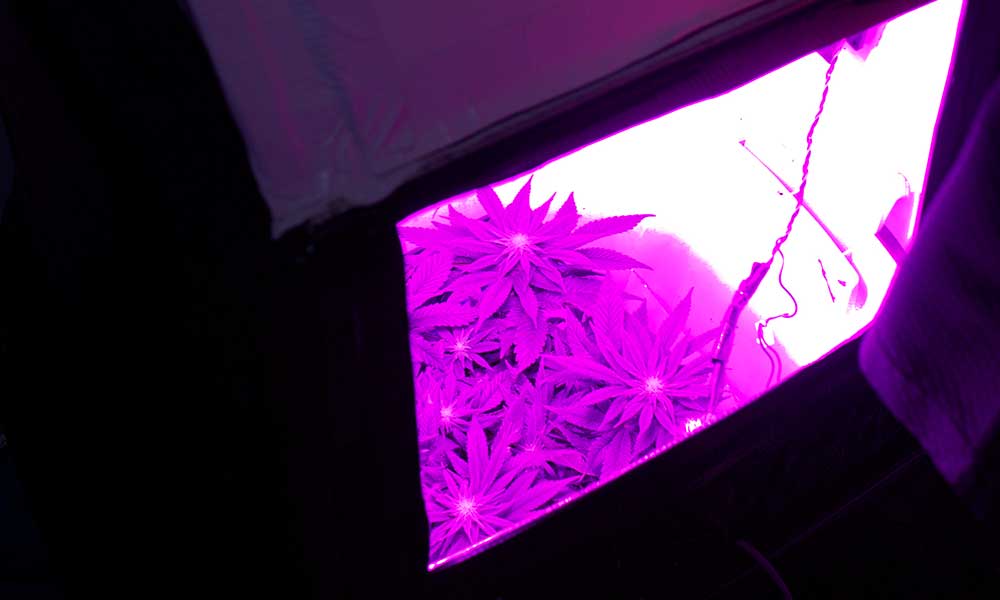
Make use of low-wattage lighting by lining the inside of a bucket with reflective material. (Photo by Alex Royan/High Times)
The concept is undeniably elegant. Cannabis isn’t a difficult plant to grow, but it is notoriously picky about lighting. Unlike a closet-grow setup, which can call for hundreds of watts of power, a well-built space bucket reflects nearly all the light output back to the plant, and many growers have eked out defensible harvests with just 100 watts of LED or compact fluorescent lighting—with an electric bill uptick of just 10 or 20 dollars, depending on local rates.
There’s also a certain erudition. John affects a Boston folksiness, but as he speaks confidently about vapor pressure, density and soil acidity, it becomes clear that he’s a deeply experienced gardener with a citizen scientist’s enthusiasm for documentation and experimentation—and that part of the space-bucket ethos that drew him in is the opportunity to control every input a plant receives.
“It’s like playing God, man,” he says with a grin. In fact, John and a few friends are currently planning an experiment in which they’ll set up a handful of space buckets with identical conditions so that they can change one variable—the hours of light they give the plant during the flowering phase, say—and lab-test the potency of each harvest afterward to expand the knowledge base of effective indoor-growing praxis.
Bucket Heads
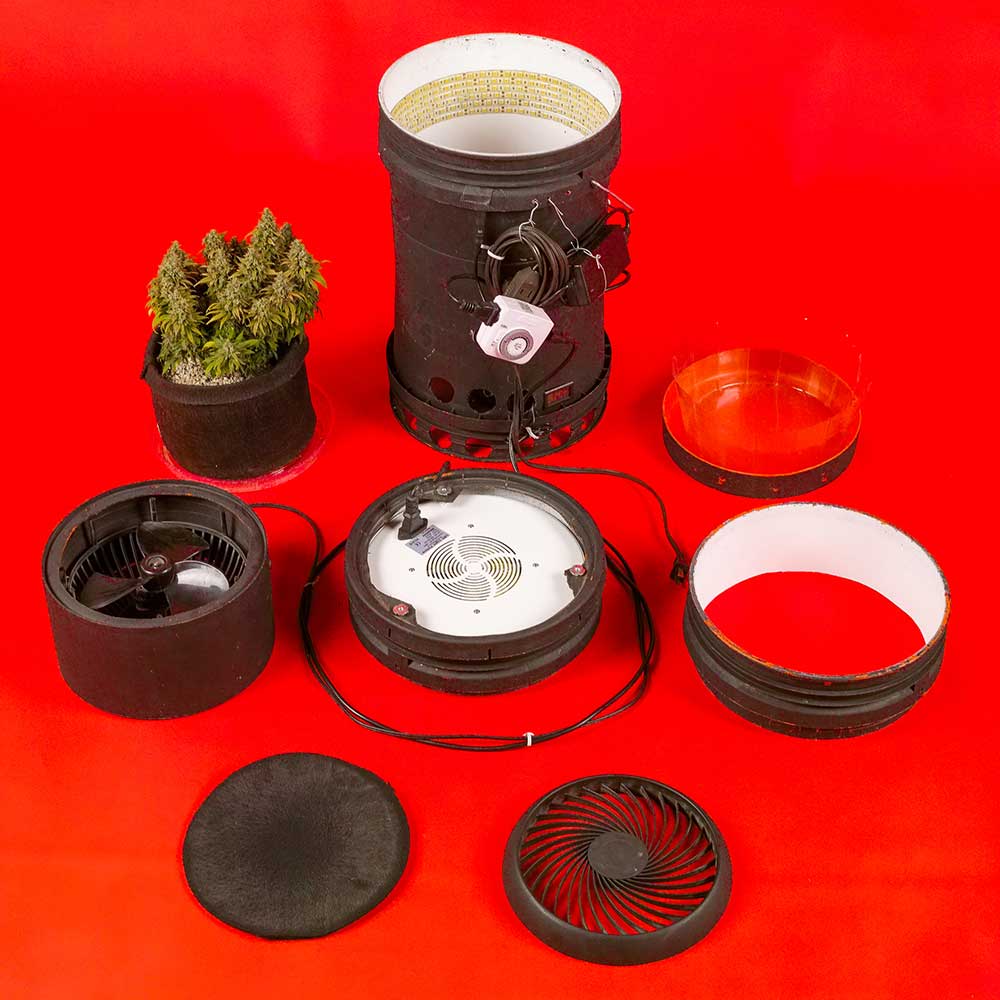
You can piece together a space bucket from parts available at any hardware store. (Photo by Redditor BudsForever)
Space buckets were originally the brainchild of a pseudonymous Web developer in Buenos Aires who goes by the Internet handle Ekrof (who, though he takes pains to note that he later discovered a few similar designs that had been floating around the Web prior to his work, unquestionably popularized the concept).
“My first plant failed to grow because of the little sunlight I got in my apartment,” Ekrof said in an online interview. “That is when I decided to add a CFL bulb to the lid of the bucket, and a couple PC fans to keep the air running. This basic design turned out to be very effective and easy to tweak and upgrade.”
Ekrof recalls that he coined the term about five years ago, after photos of his space bucket and subsequent harvest he uploaded to a forum elicited astonishment from fellow growers. He ended up registering spacebuckets.com, a site that features user-uploaded space-bucket builds and grow guides, as well as a subreddit in which space bucketeers discuss the finer points of nutrition, lighting, carbon filters and more. Some have even documented experiments in growing plants other than cannabis: strawberries, wasabi, kitchen herbs and even avocado sprouts.
“We are a community of learners, a movement of tinkerers,” Ekrof said. “Most importantly, we believe in the free flow of ideas and the unparalleled power of the Internet.”
Building Buckets
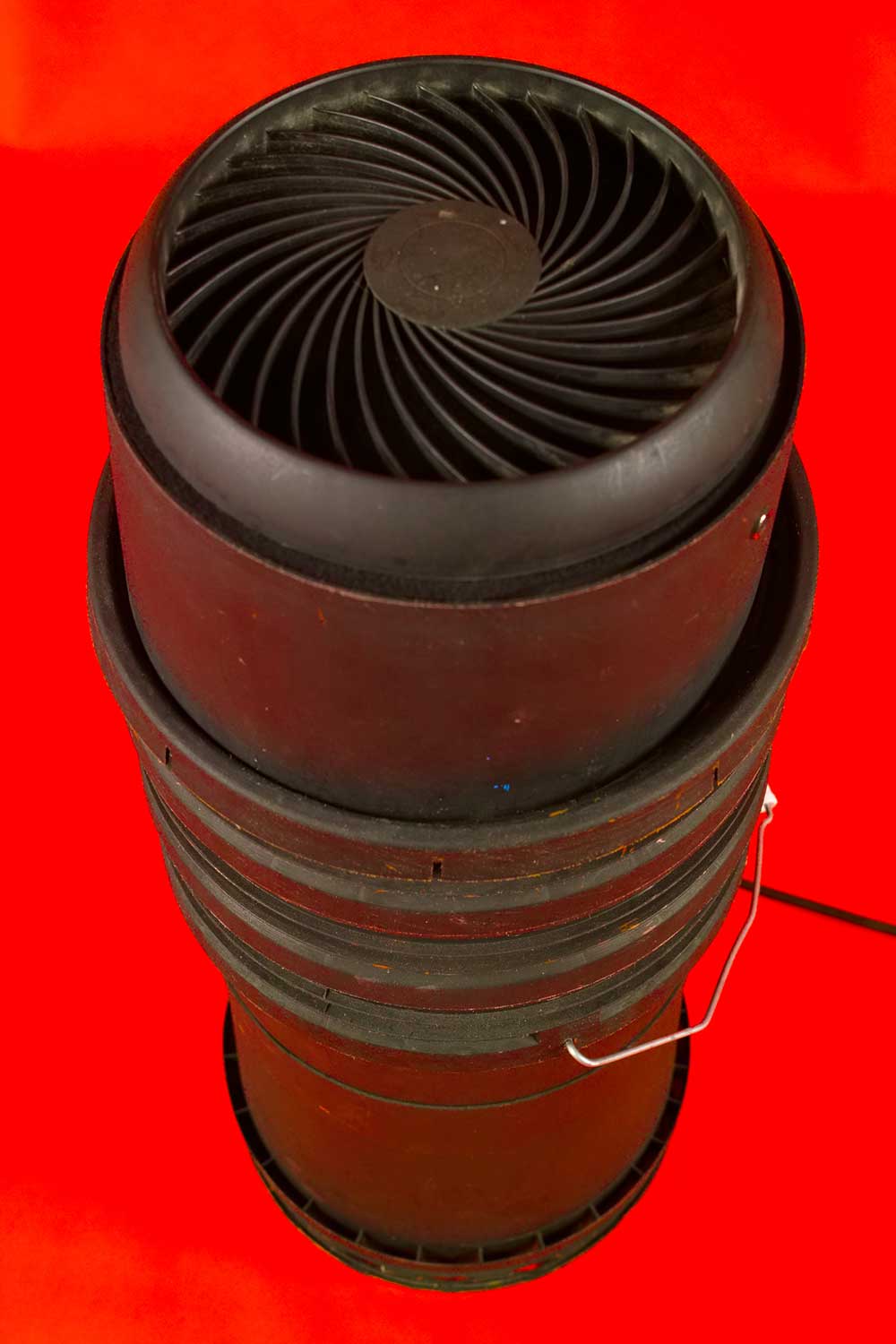
Repurposed fans provide cheap ventilation (Photo by Redditor BudsForever)
Builds can be sophisticated—John designed his so that he can use his smartphone to check temperature and humidity, and even turn the lighting on and off remotely, using an Arduino board—but Ekrof emphasizes that a bucket doesn’t need to be that complex. His first prototype, the one that caught the interest of so many growers back in 2013, was cobbled together from a couple of 5-gallon buckets, reflective tape, a few small fans and a handful of CFL bulbs.
You can grow your own quality bud today, he says, with a similar setup and a low entry cost. John’s space bucket, which is large and unusually complicated, cost about $300 including everything down to the plant food; a simpler setup, with fluorescent lighting, might run closer to $100. (Check out the guide at the end of this story for more info on how to build your own space bucket.)
And if you’re not handy with tools, there are signs that a cottage industry has started to spring up of artisans who build and sell their own space buckets. CJ Cummings, who sells artisan space buckets through an Etsy store called MostlySafe out of Portland, OR, says that he sold about 20 units last year for $275 apiece, and hopes to move more going forward.
Outer Space
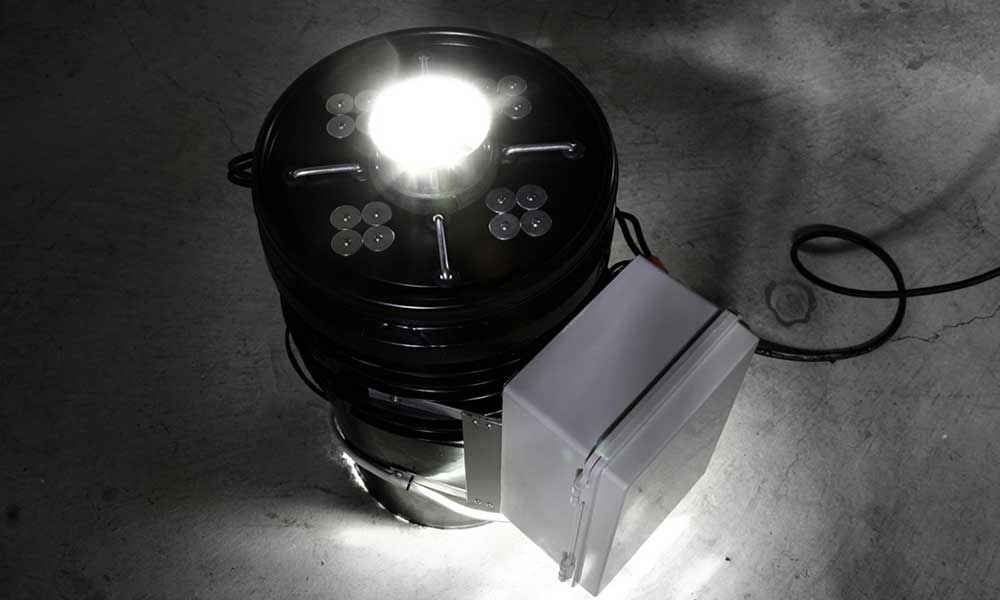
Space buckets let avid gardeners control all of a plant’s inputs. (Photo by Morrigan_Disapproves)
“In five to seven years from now, you’ll see space buckets being sold like hydro grow sets,” Cummings says. “You need only look in the past to see how products have become mainstays.”
Cummings first started thinking about tiny, controlled grow chambers when he was watching episodes of Star Trek: Voyager involving the airponics bay maintained by the alien character Kes; Cummings started Googling and soon ended up on the space-buckets subreddit. The rest, he says, is history.
“If we are going to go into space, and I hope we do, we need to have ways we can grow bountiful amounts of food in a controlled environment,” Cummings says.
The winter in Boston is long and cruel, and it’s lingered this year into a dismal gray spring. Back on the South Shore, as we watch the artificial sunlight spill out from John’s bucket, I’m overcome by the illogical urge to climb in, hunker down and bask in its warm brightness until the weather warms, the days lengthen and greenery creeps back into the landscape.
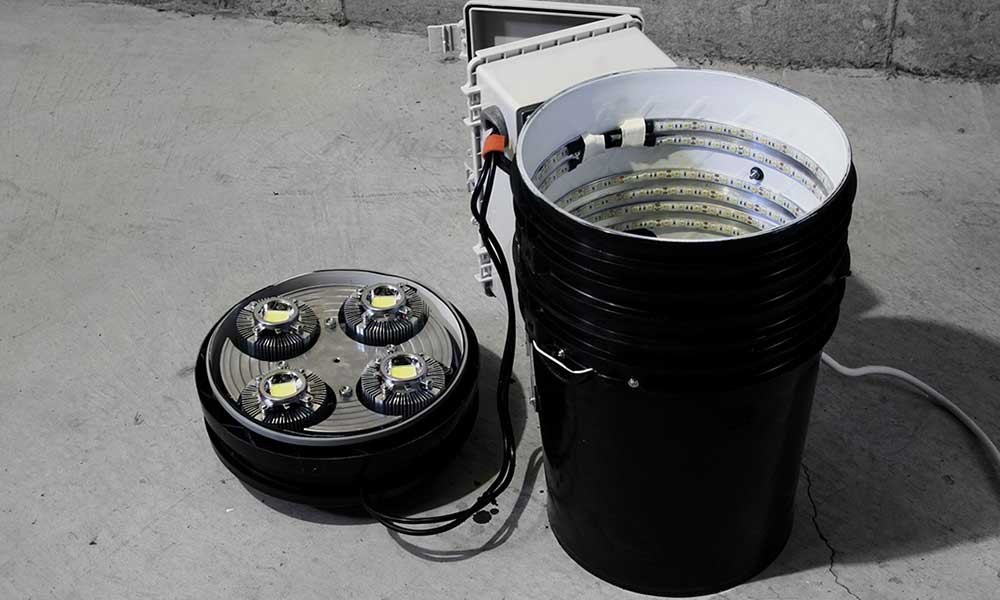
Some growers use a combination of top and LED strip lighting. (Photo by Morrigan_Disapproves)
Space Bucket Materials:
- 3 5-gallon buckets
- 1 5-gallon bucket lid
- 1 roll black duct tape
- 1 bottle Gorilla Glue
- 1 roll reflective Mylar
- 2 12-volt, 80-mm computer fans
- 1 12-volt power supply
- 4 wire nuts
- 10 small zip ties
- 3 bolts
- 3 nuts
- 1 4-socket light fixture [pictured]
- 4 23-watt compact fluorescent bulbs
How To Make Space Buckets
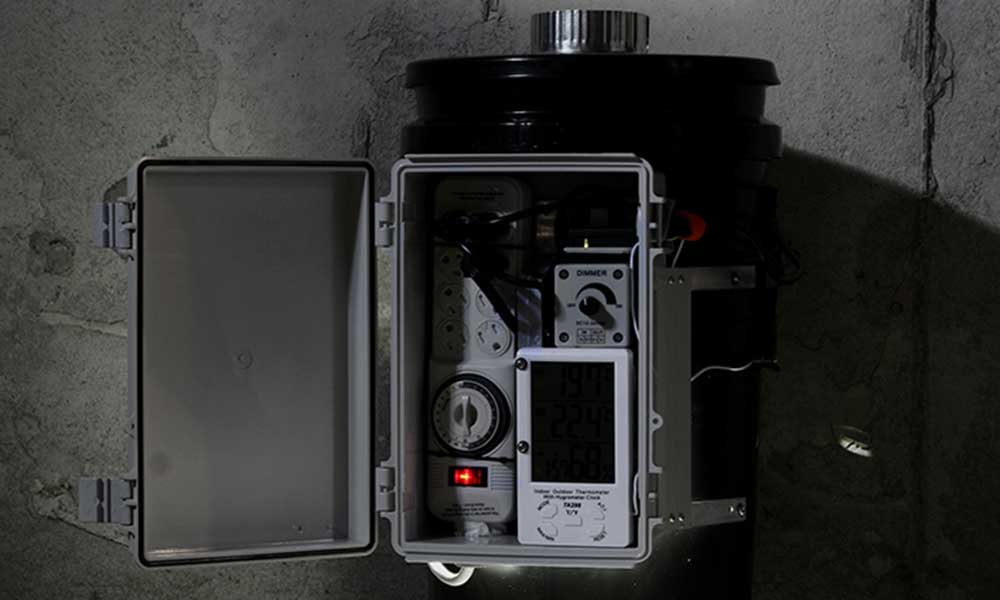
Controls range from a simple on-off switch to sophisticated automation systems. (Photo by Morrigan_Disapproves)
Step 1: Wrap the exterior of one 5-gallon bucket in black duct tape. Use glue to coat the interior with sheets of reflective Mylar. Drill drainage holes in the bottom. Drill four small holes on the side and run zip ties through them to attach the power strip.
Step 2: Use a serrated knife to cut two holes for the fans in the wall of the same bucket. Drill another small hole near each fan opening, then run zip ties through them to fix the fans to the bucket, one as intake and one as exhaust. Use wire nuts to connect the fans to the 12-volt power supply.
Step 3: Cut the bottoms off two more buckets to create spacers to add height when your plant outgrows the first bucket. The 5-gallon buckets should nest perfectly, so no light should escape when the buckets fit together. Save the bottom of one of the spacer buckets to catch drainage.
Step 4: Cut the bottom off the fourth bucket, the same way you made the spacers. Duct-tape the lid to it and cut a hole in the lid in the shape of your light fixture. Duct-tape the light fixture to the lid so that only the bulbs emerge inside. Finally, wrap the exterior in duct tape to keep light from escaping.
You can find much more information about space buckets at Spacebuckets.com and Reddit.com/r/spacebuckets.
The post Buckets Full Of Sunshine: How To Make Your Own Space Buckets appeared first on High Times.

